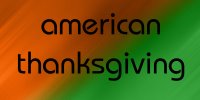American Thanksgiving: The Famous One
 The American Thanksgiving has been around for ages, and harvest feasts of thanks were held long before the famous pilgrim-indian feasts, as we found out in part one. But what all happened on that day in 1621? TDI has scoured the web, and we've brought you the answers for part two of our special series, An American Thanksgiving.
The American Thanksgiving has been around for ages, and harvest feasts of thanks were held long before the famous pilgrim-indian feasts, as we found out in part one. But what all happened on that day in 1621? TDI has scoured the web, and we've brought you the answers for part two of our special series, An American Thanksgiving.
In 1621, the Plymouth colonist and the Wampanoag Indians shared in a harvest feasts of thanksgiving. According to Edward Winslow in the A Journal of the Pilgrims at Plymouth, they indulged in a feasts of bird and deer. And according to The History Channel, Turkey, Goose, Crane, Swan, Seal, and an assortment of vegetables may have also been on the menu for the great feast.
The feast also took place sometime between Sept. 21 and Nov. 11. In 2005, it is held on November 24. The original harvest feast was also three days long. That's alot of feasting! In 1817, the state of New York adopted Thanksgiving Day as an annual custom, and by 1863, Abraham Lincoln appointed a national day of Thanksgiving to occur on the last Thursday in November.
But to the Pilgrims and the early American settlers, it was not a few days just for feasting. Rather, it was a series of days for religious gratitude. Here are selections from a Thanksgiving proclemation from 1782:
Thanksgiving was held by the Christian settlers to give thanks to God for what he had given them that year. Harvest feasts were infrequent as the years went on, until official proclemations by the states and eventually by the American government made it a national holiday. As we celebrate it today, it is one day, and not three. In our final part, we'll look at the evolution of an American holiday."It being the indepensable duty of all Nations, not only to offer up their supplication to ALMIGHTY GOD, the giver of all good, for his gracious assistance in a time of distress, but also in a solemn and public manner to give him praise for his goodness in general, and especially for great and signal interpositions of his providence. . . The observation of THURSDAY the twenty-eight day of NOVEMBER next, as a day of solemn THANKSGIVING to GOD for all his mercies: and they do further recommend to all ranks, to testify to their gratitude to GOD for his goodness, by a cheerful obedience of his laws, and by promoting, each in his station, and by his influence, the practice of true and undefiled religion, which is the great foundation of public prosperity and national happiness."

No comments:
Post a Comment